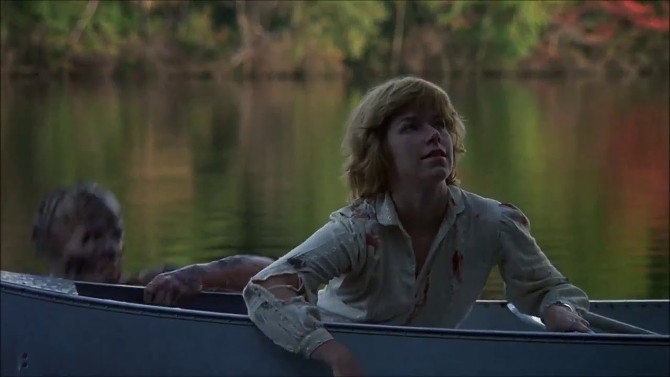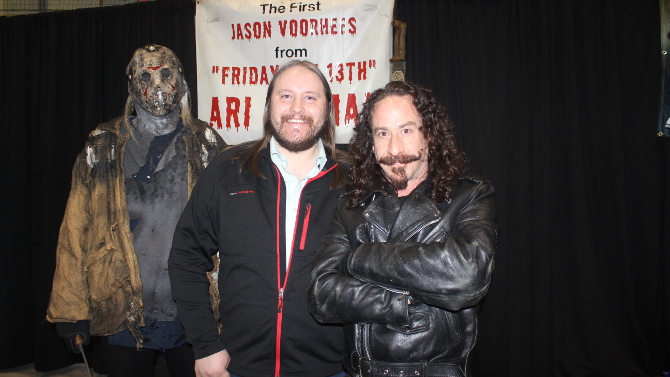In a mere seven year span, three of the most iconic horror spooks of all-time were created: Michael Myers in Halloween (1978), Jason Voorhees in Friday the 13th (1980) and Freddy Krueger in A Nightmare on Elm Street (1984). Each has spawned a nearly inordinate amount of sequels and remakes: not including the original, nine (and soon to be ten), eleven, and eight, respectively. . . with one of those being a crossover – 2003’s Freddy vs. Jason. It is somewhat reminiscent of the creative juices that were flowing in the horror craze of the 1930s and 1940s, when original, folkloric, and literary monsters became the stuff of Hollywood legend – think Dracula, The Invisible Man, Frankenstein, The Wolfman. . . and later (in the 50s), the Creature from the Black Lagoon (all of these films also produced a bevy of sequels).
With Halloween already having been reviewed this past Halloween and A Nightmare on Elm Street being planned for this upcoming October (a perfect time to celebrate its thirty-fifth anniversary), Friday the 13th is on the chopping block today. Part of the slasher subgenre, it was released in the period’s Golden Age – 1978-1984, following in the wake of John Carpenter’s successful low-budget horror film.
Co-written and directed by Sean S. Cunningham, it finds its place somewhere between Psycho and Halloween, a tale set in rural America, where, a new owner, Steve Christy (Peter Brouwer) has put some major money into resurrecting a dilapidated summer camp (resting on the shores of Crystal Lake) which has a nefarious background. Still whispered about by the nearby townspeople, a boy drowned in the water back in the 1950s, and the next year, two camp counsellors were murdered by an unknown assailant (this is how the picture opens). . . all of this has fed into a collective perspective that the location is cursed.
Bringing in a group of camp counsellors from the outside, Alice (Adrienne King), Marcie (Jeannine Taylor), Annie (Robbi Morgan), Jack (Kevin Bacon), Bill (Harry Crosby – son of Bing), Brenda (Laurie Bartram), and Ned (Mark Nelson) will be in charge of managing the day to day activities of the soon to be arriving children.
Yet, all is not alright at the serene looking locale. Hidden amongst the calm lake, lush forest and romantic rustic log cabins is an unseen murderous villain, and soon, one by one, the teen camp counsellors fall prey to the butcher’s hand.
To those coming to the film for the first time with a modern knowledge of Jason Voorhees, they will be surprised that the resurrected hockey masked killer is never seen in the movie (this iteration only arrives in part three). . . in fact, until close to the very end, we are left in the dark as to who the murderer actually is. With the camera nearly always moving (it is often handheld), Cunningham makes the wise decision of infrequently showing small body parts of the villain (feet walking or fingertips), for the most part visualizing the antagonist’s first person perspective (a voyeuristic feeling to be sure). Soon, the viewer is quite unsure as to whether it is a third person viewpoint we are seeing or if we are actually watching the killer stalk the mostly unassuming counsellors – which provides a rather tense, suspenseful atmosphere (the sparse music, written by Harry Manfredini, famous for its creepily sung “ki ki ki, ma ma ma” overlay, is only evident when the murderer is present, further adding to the tense scenario). Though different from what the franchise would eventually become, there can be no arguing who the first Jason is. . . played by Ari Lehman, he aptly demonstrates the plight of the poor boy – drowned all those years ago, his spirit never truly at rest. And though his part is small, it leaves an ever growing ripple in its wake, a most memorable moment that still haunts audiences all these years later.
An early slasher film, Friday the 13th develops a successful one dimensional pattern that would be reused time and time again within the subgenre. It is quite evident that the script is simply there to support the suspenseful stills that make way for the macabre thrills. Tropes such as the sex crazed teen, secluded locales, psychopathic killer, lame excuses to separate (washroom break, left my window open and my room will get wet), and stupid survival choices (once again, usually the distracted teens), are clearly evident. Characters are there not to be well rounded individuals, but are instead, targets for the assailant. Though they may be considered cheap thrills, they are clearly not. . . often executed in clever ways, they entertainingly drive the proverbial roller coaster forward at a torrid pace, an edge of your seat suspenseful thrill ride that builds right to the climax. There are countless examples, from a sharply lit axe/door scene that will bring to mind The Shining (which, interestingly, was released the same year), to the surprising ending that transitions from placid calm to sheer horror in a split second. Intriguingly, the ending was reworked from Brian De Palma’s Carrie, which itself was inspired by the conclusion of John Boorman’s Deliverance – which it actually has more of a connection to than the former.
Despised by most critics at the time, both Gene Siskel and Roger Ebert trashed the film on their show – attempting to dissuade people from going, they spent an entire episode lambasting the movie – while the latter actually spoiled the ending. . . he also published both Paramount owner Charles Bluhdorn and actress in the film Betsy Palmer’s addresses – hoping that fellow haters would write them to complain (funnily enough, the address for Palmer was incorrect). Only building over the years, Friday the 13th has an ever growing rabid fan base, making it a true cult classic – a film of its time that not only influenced countless slasher flicks to come, but still has quite the spark left in it. So, return to Camp Crystal Lake for the mother of all jump scares, this Friday the 13th won’t bring you any bad luck.


